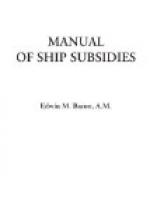As it now stood it was shorn of the provisions for lines from the Pacific coast to Japan, China, the Philippines, and Australasia. The new subsidized lines were all to run to South America. Two of these were to run from the Atlantic coast to Brazil and Argentina, respectively; one, from the Pacific coast to Peru and Chile; and one from the Gulf of Mexico to Brazil. On all four lines sixteen-knot steamers were required, with speed on the average above the European mail lines to South America. The subsidies were reserved exclusively to ships to be built in the United States, so that the mail service could not be performed by existing steamers; thus a wholly new ocean-mail fleet was guaranteed.[IF]
The bill was reached in the Senate March 2, and strenuous efforts were made by Senator Gallinger and others to push it through. But it failed in the closing hours of the session to reach a vote. So this measure fell.[IG]
Another effort was made in the Sixtieth Congress. In his message at the beginning of this Congress (December 2, 1907) President Roosevelt recommended an amendment to the act of March 3, 1891, “which shall authorize the postmaster-general in his discretion to enter into contracts for the transportation of mails to the Republics of South America, to Asia, the Philippines, and Australia at a rate not to exceed four dollars a mile for steamships of sixteen-knots speed or upward, subject to the restrictions and obligations” of that act. In other words, to give the same subsidy to steamers in these services as allowed to the twenty-knot American mail transatlantic line, instead of two dollars a mile.[IH] A bill to this effect was introduced in the Senate December 4[II]; on February 3, 1908, was reported back from the committee on commerce so amended as to provide the four-dollar-a-mile subsidy to American sixteen-knot steamers on routes of four thousand miles or more to South America, the Philippines, Japan, China, and Australasia; was debated at length; further amended; and finally, passed, March 20. In the House it was referred to the committee on post office and post roads;[IJ] issued therefrom in a dew draft;[IK] debated; and finally failed to pass. Thereupon the subsidized service to Australia by way of Honolulu and the Samoan group was abandoned.
Again the measure was pressed in the Sixty-first Congress. It now had the backing of President Taft. In his annual message December 9, 1909, “following,” as he graciously said, “the course of my distinguished predecessor,” he earnestly recommended the passage of a “ship-subsidy bill looking to the establishment of lines between our Atlantic seaboard and the eastern coast of South America, China, Japan, and the Philippines.” The bill, as introduced by Senator Gallinger (February 23, 1910), provided for subsidized lines of the second and third classes on routes to the points named by Mr. Taft, four thousand miles or more in length outward voyage, or on routes to the Isthmus of Panama:




